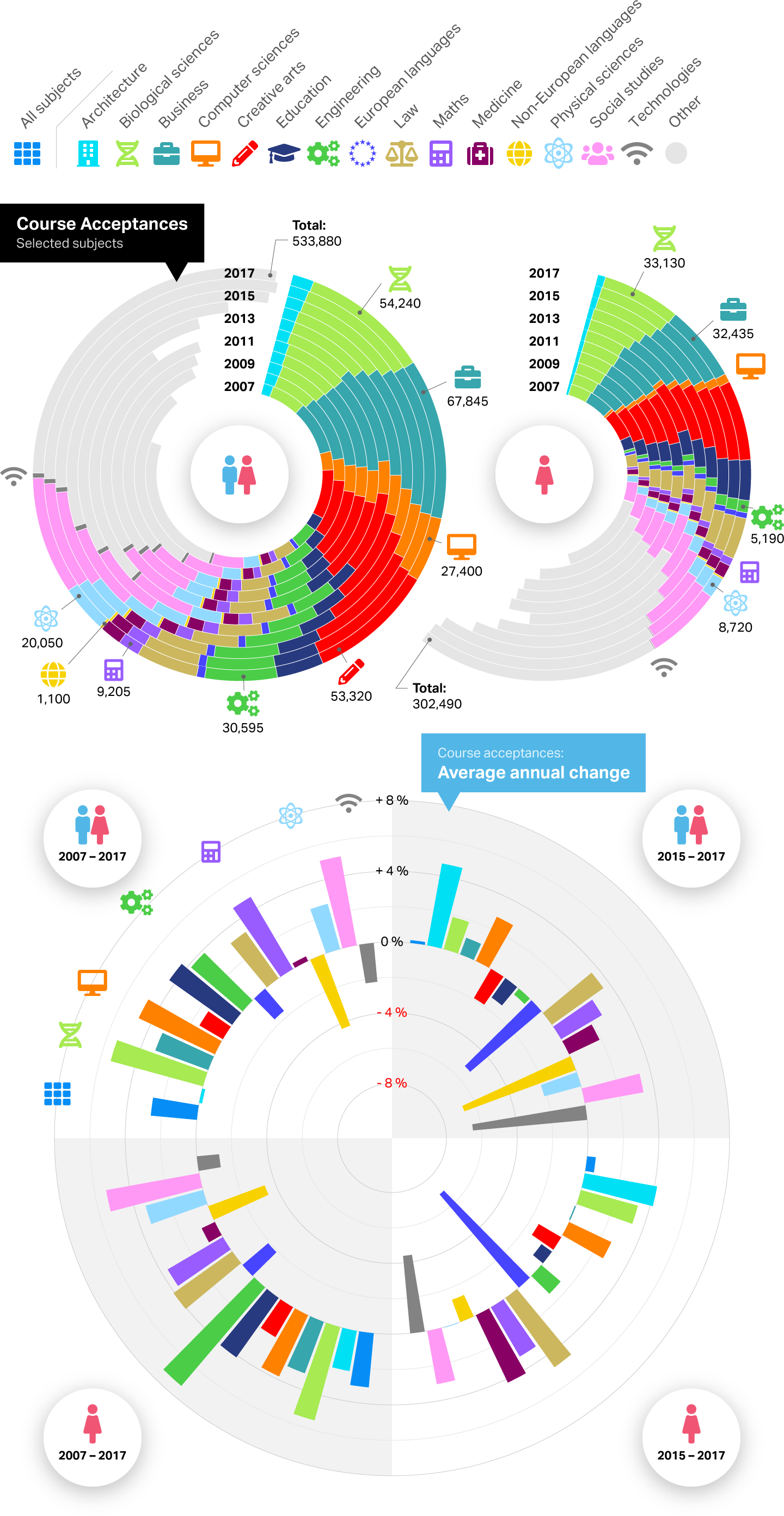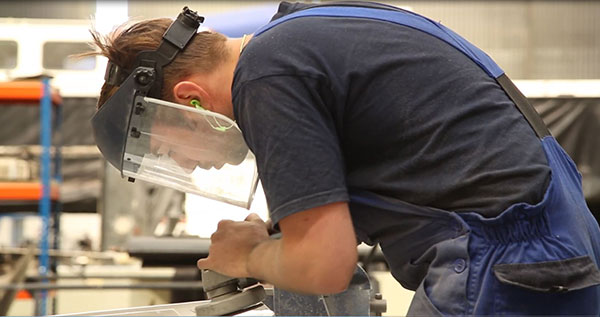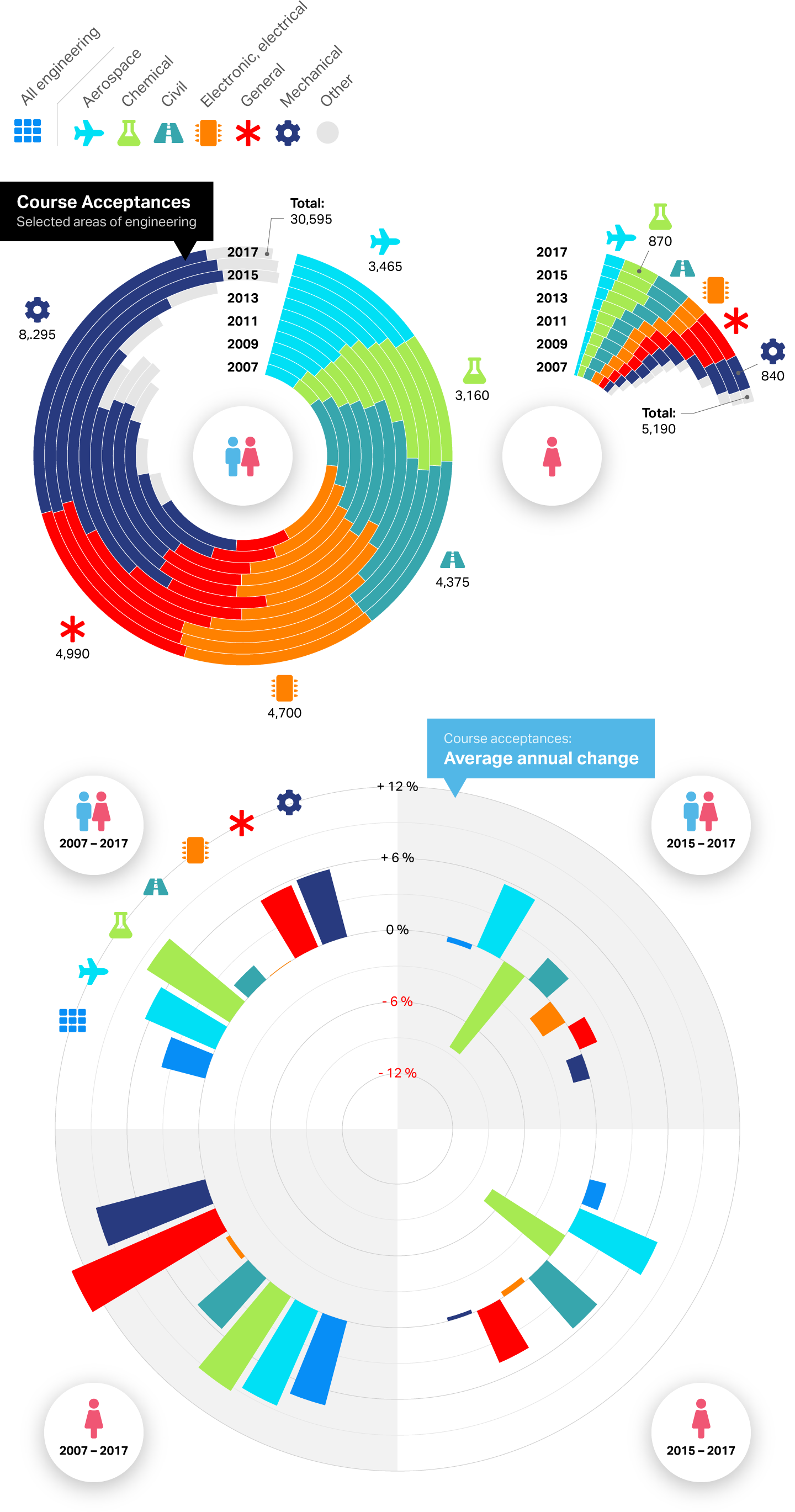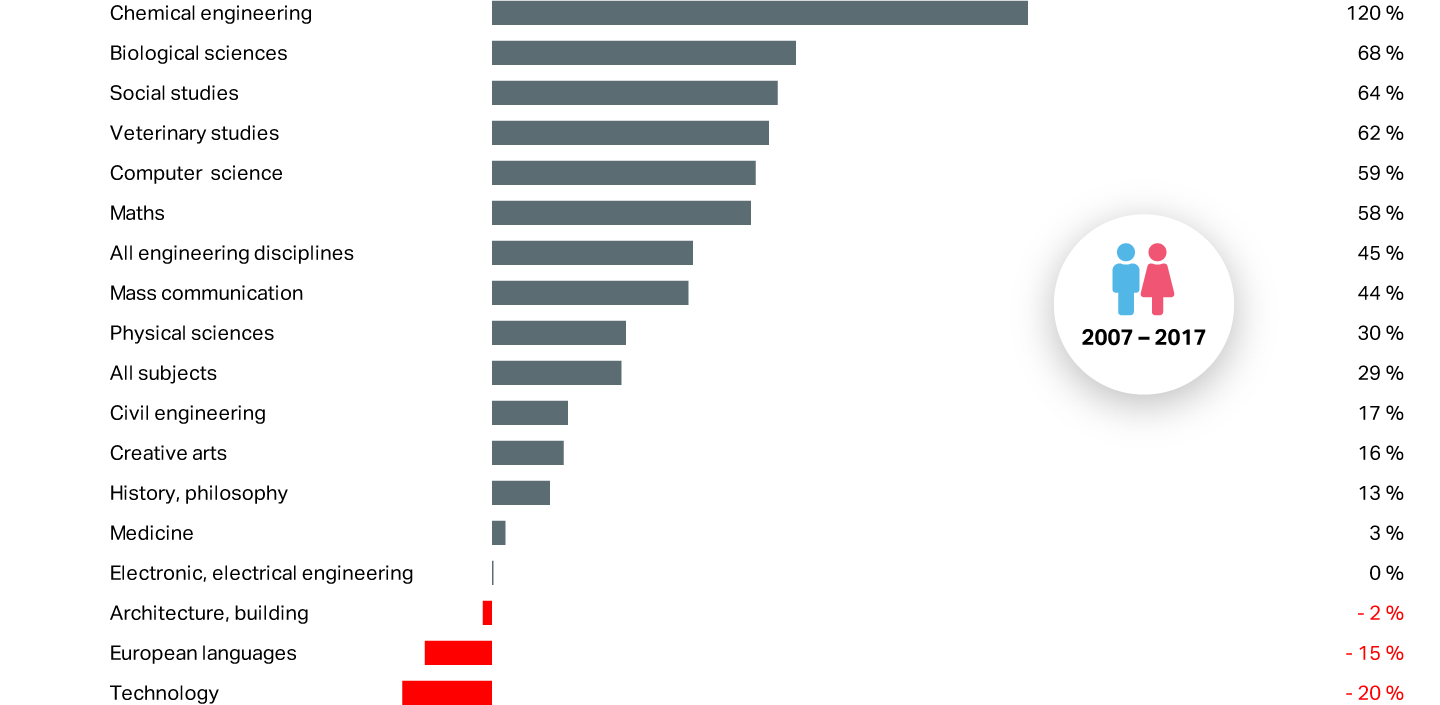A Made Here Now analysis of university data shows how engineering has fallen back in the pecking order of top subjects, amid fresh worries on skills shortages. We also shed light on the relative attractiveness of individual engineering disciplines.
Fall in engineering attractiveness triggers concern
The number of students choosing engineering at university has
started to fall, reversing a ten-year rising trend, a finding likely to
bolster efforts to increase the effectiveness of engineering promotion
schemes.
Since 2015, the intake of students accepted for UK undergraduate
university engineering courses has slipped for two years in a row,
signifying that engineering has fallen behind other academic subjects in
recruitment rates.
Enrolment of female engineering students – a key target in a
male-dominated industry – has continued to grow but at a slower rate
than previously.
An analysis by Made Here Now, based on data from the university admissions body UCAS,
shows that between 2007 and 2017 the number of people accepted by
universities for engineering courses rose by almost half, bolstering
hopes that the UK was starting to challenge the belief that engineering
was a declining profession.
But the 2016 and 2017 intakes both shrank despite the efforts of
roughly 600 organisations to encourage more young people to study or
work in technology-based disciplines.
While in 2015, new registrations for engineering courses rose by 6
per cent on the previous year, in 2016 there was a 0.3 per cent drop,
followed by a 0.6 per cent fall in 2017. During 2007-17, numbers of
women accepted on engineering courses rose by an average of 7.3 per cent
a year. In the final two years of this period the annual increase fell
to just 1.4 per cent (see Fig. 1).
The overall trends for engineering have been weaker than those for
the broad level of university admissions – even though virtually all
subjects have been hit by several negative pressures including a slide
in applicants from other European Union nations and the rising costs for
taking a place at university. In 2016, acceptances across all subjects
monitored by UCAS showed a 0.5 per cent rise, followed in the next year
by a 0.2 per cent reduction.
Winners and losers in a changing university landscape
 Fig. 1: Analysis of UK undergraduate course acceptances, selected subjects
Fig. 1: Analysis of UK undergraduate course acceptances, selected subjects
Source for all charts: Made Here Now analysis based on UCAS data
Engineering seems to have been more affected than other disciplines
by the EU issue and a reduction in the number of “mature” students who
start academic courses in their 20s and later.
Despite the caveats, Terry Scuoler, chairman of the Institute of
Export and International Trade who has recently stepped down as head of
the EEF manufacturing organisation, expressed unease at the findings. “I
am disappointed to see the drop-off [in numbers]….Government and
industry must work together to ensure this does not become a longer term
trend by reinforcing the messaging that a career in engineering leads
to highly-paid rewarding jobs in a number of dynamic and growing
sectors.”
Engineering has suffered from the same pressures that have led to a
marked slowing in demand for university courses of all kinds, notably
the increasing cost of studying for a degree and growing interest in
vocational training plus the effects of the UK’s planned departure from
the EU. But relative to the other subjects the UCAS data reveal a
slowdown similar to engineering in other science and technology
disciplines - for example physical and biological sciences - which is
likely to intensify concerns.
Encouraging more people to study these subjects is seen as crucial
in raising the UK’s economic performance by helping business growth and
reducing skills shortages.
While Prof Elena Rodriguez-Falcon, provost at the New Model in Technology & Engineering,
a new university being set up in Hereford, called the data “very
worrying”, others have cautioned against placing too much weight on just
two years of data, especially considering the positive trend
previously.

Rhys Morgan, education director at the Royal Academy of
Engineering, said: “Yes, it is a downward trend and it’s not great but
it’s not a catastrophic fall.” Even so, he says the numbers underline
the message that industry and education need to step up their efforts to
encourage more people to study technical subjects. “The combined
[promotional] activity of the [engineering and scientific] community is
not having the impact at the scale and pace required to meet the needs
of the UK.”
The Department for Education said: “We want to see even more
people, particularly women, studying STEM [science, technology,
engineering and maths] subjects …whether it’s through a technical or
academic route. It is important for the lifeblood of our economy and
will give people the skills they need to get good jobs.” The DfE is
among the government departments that have declared 2018 “the year of
engineering”, during which they plan to increase the promotional drive
among young people.
The “engineering promotion” industry spends tens of millions of
pounds a year and has been stimulated by concerns about potentially
serious skills shortages. The same concerns prompted the setting up of
Made Here Now to project a more attractive image of manufacturing.
According to the lobby group EngineeringUK,
the supply of engineering graduates in the UK falls short of demand by
about 22,000 a year. Virtually everyone in technology-based industries
highlights the need to recruit more women: in 2007 just 12 per cent of
those admitted to engineering courses were women and while the
proportion reached 17 per cent in 2017, this is still regarded as far
too low by most in the engineering community.
In sharp contrast to the situation in engineering, women far
outnumber men on courses of all kinds. In 2007 women accounted for 54
per cent of acceptances, with the figure rising to almost 57 per cent in
2017.
Detailed data for engineering show overall acceptances were
impacted by an annual fall in both 2016 and 2017 of more than 2.4 per
cent in the numbers of students taking engineering aged 19 and above,
while engineering was hit in 2017 by a 4.8 per cent drop in students
from the rest of the EU, more than twice the rate of fall for all UCAS
subjects.
Experts puzzle over university data
Dick Elsy, chief executive of the High-Value Manufacturing Catapult,
has plenty of reasons to be interested in the numbers of engineering
students. He runs one of Britain’s biggest research and development
organisations, working with industry across seven centres in fields from
new automation techniques to advanced materials.
Elsy’s organisation employs more than 2,000 people, most of them
with top-flight qualifications in engineering and related field. He is
concerned by Made Here Now’s analysis showing a drop in the numbers
going to UK universities to study engineering, after several years of
steady increases.
While he says it may be a “little early” to reach conclusions, he
adds that if the “reductions…since 2015 were to persist, that would be a
matter of severe concern.” Elsy points to industry surveys showing
recruitment of engineering and technical staff with right skills was a
barrier to business.
“If the number of engineering graduates shrinks further, that
barrier can only get higher. In pretty much every conversation I have
about the future of manufacturing, access to skilled recruits comes out
as the principal concern for UK businesses.”
Andrew Churchill, executive chairman of JJ Churchill, a
family-owned manufacturer of high-tech turbine blades based near
Leicester, is someone else monitoring the UK graduate field for the
people he needs to help run his expanding business. He says it is
“deeply saddening” that the number of people accepted for UK
undergraduate engineering courses declined by an average 0.4% a year
between 2015 and 2017, against a trend from 2007-17 showing an average
increase of 3.8 per cent a year.
“I remain convinced that part of the story in this apparent decline
is a lack of understanding as to where an engineering career can lead
you and what it involves, as opposed to a simple decline in interest
once those career opportunities have been understood.”
One seldom acknowledged reason for the drop in numbers, Churchill
says, could be shortages of design and technology teachers in schools,
leading to fewer schoolchildren studying a subject that might spark
their interest in an engineering course at university.
Bhavina Bharkhada, skills policy adviser at the EEF manufacturing
organisation, says another factor may be increased interest by young
people in vocational routes into engineering, including apprenticeships.
Demand for these has shown a broad increase in recent years.

“Despite the significant challenges that the introduction of the
apprenticeship levy [a set of charges triggered by new legislation],
apprenticeship starts in manufacturing and technology have held up,”
Bharkhada says. Others point to variations between universities in the
numbers of engineering students being taken in, with some such as
Southampton and Cambridge expanding their provision, while others have
cut back. The cuts in places could result both from the higher costs of
running engineering courses compared to many other subjects and to
reduce demand among young people.
The UCAS numbers on which Made Here Now’s analysis is based show
that in 2017 78 per cent of people accepted for engineering courses at
university had their homes in the UK, with 22 per cent coming from
overseas. Over the past decade the proportion of “home-grown” students
has increased, from 69 per cent in 2007. Acceptances of students from
both the UK and other countries have shown a marked slow-down in the
past two years, indicating similar trends are affecting both groups.
The overall decline in engineering acceptances – counting both UK
and overseas students - coincides with a broader drop in the proportion
of young people opting to go to university. This is a change related to
higher tuition fees, worries about debt and the availability of jobs for
graduates, while efforts to attract more young people into vocational
training may also be playing a part. Across all subjects monitored by
UCAS growth in course acceptances slowed to just 0.2 per cent a year
between 2015 and 2017, compared with the 2.6 per cent average annual
growth rate between 2007 and 2015.
A worrying sign, however, for many in the engineering community is
that the decline in engineering has been deeper than for many other
subjects. In architecture, for instance, the numbers accepted over the
past two years have increased by an average of 4.7 per cent, compared
with an average decline for new architecture students of 0.2 per cent a
year over the full 2007-17 period.
Engineering has grown hugely in popularity over the full 2007-17
period, with acceptances for UK university undergraduate courses rising
on average by 3.8 per cent a year. This equates to an overall rise of 45
per cent – from 21,100 entrants in 2007 to 30,600 in 2017 – and shows
that over that period engineering increased in popularity much more
quickly than the average for all degree subjects. Across the entire
university undergraduate intake, acceptances rose 29 per cent from
413,425 in 2007 to 533,895 in 2017.
Other engineering-related disciplines show a similar weakening
trend from 2015 onwards. Acceptances for physical sciences, technology,
biological sciences, maths and computer sciences have all shown much
weaker growth over the past two years compared with their longer-term
performance.
Whatever lies behind the numbers – and most agree it will be hard
to draw strong conclusions until a longer run of figures becomes
available – the data reinforce the feeling that industry and education
still have a long way to go to convince young people of the attractions
of a career in an engineering related topic.
“The challenge is a cultural one,” argues Dick Elsy of the High
Value Manufacturing Catapult. “It will take many years to change
long-held preconceptions which attach a lower value to engineering and
manufacturing. We have to keep going, get into schools and show the
wider population what modern manufacturing really looks like. Making
engineering and manufacturing an aspirational career must be the goal.”
Skills shortages could lead to more than 100,000 unfilled vacancies a year
More than half the vacancies in engineering and related fields in
the UK could go unfilled over the next 10 years, partly due to
insufficient interest among young people in technology careers,
according to a study by a leading promotional agency for engineering.
EngineeringUK says that to address these problems, schools and
other academic establishments need to improve the effectiveness of their
links with employers and improve on ways to boost pupils’ interest in
jobs in engineering and science, perhaps through a period of further
study.
“The engineering sector is of vital importance to the UK, yet
demand for people with engineering skills is not being met by supply
through the UK education pipeline. Concerted effort is needed to address
the shortfall of engineers if [the] economic and social contributions
[of engineering] are to be maintained,” says an EngineeringUK report - a weighty analysis of the engineering sector updated yearly.

The engineering body also calls for improved evaluation of the many
existing schemes to fire young people’s interest in these fields, to
“identify and implement” the approaches that have the greatest
potential.
According to EngineeringUK, the current supply of qualified people
coming through the educational pipeline suggests that the UK faces an
annual shortfall of up to 110,000 engineering technicians and graduates
over the next few years. This would leave as many as half the likely
vacancies unfilled.
Each year up to 2024, the report says, there will be an average of
about 203,000 job openings in the economy for people with a high level
of engineering qualification broadly equivalent to qualifications as
least as high as an advanced apprenticeship.
The probable supply of people with the necessary skills is likely
to be between 93,000 and 120,000 a year, leaving a gap of up to 110,000 a
year.
The analysis comes as many of the 600 groups organising promotional
schemes for engineering and similar fields take a fresh look at their
efforts in the wake of research suggesting that many have not been
sufficiently effective. EngineeringUK itself came in for criticism in a 2017 inquiry by the barrister Prof John Uff on the overall impact of promotional schemes for engineering.
Paul Jackson, the organisation’s previous chief executive has left,
and Mark Titterington, his replacement, is revamping its strategy,
particularly looking at how it links with other agencies. Made Here Now
has been set up to raise awareness of employment opportunities in
manufacturing and to provide a link between many of the existing
programmes.
EngineeringUK is one of the biggest players in organising
promotional schemes to encourage interest in engineering and related
disciplines. In 2016/17 it spent more than £10m on promotional
activities, the best known of which is the annual Big Bang fair, which
aims to inspire schoolchildren to learn more about jobs.
A key thrust for the organisation is its collaboration with the
Royal Academy of Engineering on an ambitious new £3m programme called This is Engineering that uses social media to send out positive messages to teenagers.
The initiative – which organisers want to last for 10 years assuming
they can raise more money – was organised at the request of big
companies concerned about skills shortages. Most of the funds for the
programme are coming from large employers including BAE Systems,
Rolls-Royce and BP.
EngineeringUK believes its efforts to promote interest in
engineering careers must overcome the government’s failure to provide
good quality general careers guidance. “Careers provision [in schools in
England] is patchy and can miss those who need it most. A marketised
landscape of external careers support has grown up to fill the gap,
which schools struggle to access or differentiate,” EngineeringUK says
in its new study.
In the engineering promotion field, better co-ordination of the
many existing schemes is required to “help schools select and access the
most impactful interventions”. EngineeringUK points out that many
schools already engage with employers through programmes of “work
experience” for young people, alongside factory visits or talks in
schools by business leaders. However, the promotional efforts are much
more effective if they are “planned alongside generic careers support
and other STEM [science, technology, engineering and maths] enrichment
experiences”.
The report says schools and promotional agencies should do more to
co-ordinate their activities. “There is evidence that… [promotional
schemes] raise short-term interest in engineering careers, but a planned
succession of interventions may be necessary to sustain positive
attitudes.”
There are positive signs. According to market surveys cited by
EngineeringUK, the proportion of young people aged 11 to 19 who would
consider a career in engineering has grown from 40 per cent in 2013 to
51 per cent in 2017.
“The challenge is to sustain their interest as they progress, and
to convert that ‘in principle’ interest into more conscious
desirability. Interest drops off as pupils grow older, and this decline
is particularly pronounced for girls after the age of 14.”
Chemicals scheme proves a winner
A project to make a key branch of engineering more attractive to
young people has been hailed as a success, after it contributed to a big
rise in the numbers enrolling for chemical engineering courses at
universities.
The whynotchemeng scheme organised by the Institution of Chemical
Engineering with support from industry and universities relies on
long-term contacts with almost 900 UK secondary schools backed up by
online information about careers.
Other elements to the scheme include classroom information
resources for teachers plus a network of speakers that schools can call
on to discuss careers. The project may act as a template for other
programmes to promote engineering, many of which have been criticised
for being under-powered.
Between 2007 and 2017, the number of new students accepted on
undergraduate courses for chemical engineering rose 120 per cent, a
bigger rise than for virtually any other mainstream subject taught in
universities, according to an analysis by Made Here Now based on data
from the university admissions body UCAS (See Figs. 2, 3 and 4 in the story below).
The surge in acceptances was significantly higher than the
comparable 29 per cent rise for all subjects monitored by UCAS – from
maths to languages - and was also well above the 45 per cent increase
across all engineering disciplines. Over the 11 years, the numbers
accepted on chemical engineering courses rose from 1,455 to 3,160.
Among all the subjects categorised by UCAS, the only ones that
achieved a bigger increase in course acceptances between 2007 and 2017
than for chemical engineering were anthropology and astronomy. These
subjects saw a rise of 180 per cent and 133 per cent respectively –
however both are considerably smaller than chemical engineering in
student enrolment.
During the period, chemical engineering courses also saw a big
increase in the number of women students – a key area for study because
of the drive to make engineering less male dominated.
Acceptances by women on chemical engineering courses rose by an
average of 9.4 per cent a year during the time under study, higher than
the 7.3 per cent annual rise for the whole of engineering. Also notable
was the 13.1 per cent comparable rise for women starting courses in
general engineering - which cater for people keen to learn about a
spread of disciplines. According to the UCAS data, general engineering
is the best performer among engineering topics, measured by a rise in
course acceptances by women.
Whynotchemeng has caught the attention of Prof John Uff, a
barrister who in 2017 produced a highly critical report on efforts to
promote engineering among young people, concluding that many projects
are ineffective and wasteful. Made Here Now has been started as an
effort to fill the gap between many existing schemes and link up the
best of them.
In a recent paper, Uff says the whynotchemeng programme has
achieved “notable success” in “driving a sustained and steep increase in
the number of chemical engineering students at UK universities”. The
campaign underlines, he says, that – in the light of the relative
failure of many other ventures - “a carefully designed promotion scheme
[for engineering] can succeed”.
Industry sponsors have contributed roughly half the £1.8m that
whynotchemeng has cost since it was started in 2001. Among the donors
have been ExxonMobil, Royal Dutch Shell, Ingen, Amec Foster Wheeler and
Johnson Matthey. The UK Chemical Industries Association, a trade body,
says: “Chemical businesses across the UK have been pleased to support
whynotchemeng. It is an initiative that successfully sets out what
opportunities could be available for a career ahead after studying
chemical engineering.”
In the past two years, however, some of the gloss has come off the
project, as student numbers for chemical engineering have fallen, in
line with a broader decline in the numbers of students studying all
branches of engineering (see the first story in this package).
While the numbers of acceptances for places on chemical engineering
courses rose by an average of 8.2 per cent a year between 2007 and
2017, in the final two years of this time, the numbers fell by an
average of 8.5 per cent a year, marking a surprising turnaround.
The institution is trying to assess what lies behind the change,
according to Claire Cooke, campaign officer for whynotchemeng. “It’s
not just an issue for chemical engineering, [as] most other engineering
disciplines have seen the same problem,” Cooke says. As a result of the
disappointing recent record, her institution is rethinking some parts to
whynotchemeng to “see where we should be focussing our efforts or
collaborating with others better.”
Up to now, a core element to the scheme, according to Cooke, has
been its targeting of individual schools identified as having teachers
interested in chemical engineering who might be expected to enthuse
pupils. She explains: “We sent information to an initial mailing list of
500 schools across the UK who were either known to send students onto
STEM [science, technology, engineering and maths] university courses, or
who already had an existing relationship with [the institution]. We
sent various mailings each year to [heads of science or of careers] and
took care to manage our mailing list to ensure up-to-date contact names.
“We sought feedback from teachers… and also spoke to students
beginning chemical engineering first degree courses who told us that it
was more likely to be their science teacher rather than a careers
contact who first told them about chemical engineering.”
Another part to the scheme involved the institution working closely
with industry to develop case studies, marketing literature, teaching
resources and web content that was judged relevant and informative.
Cooke says much of the effort was aimed to address the “general
lack of understanding on what types of jobs [in this specific branch of
engineering] are available”.
She adds: “The (perhaps incorrect) perception of a declining UK
manufacturing industry just adds to the assumption that there are no
jobs for engineering graduates. There’s a widely publicised skills gap,
but no real information on the types of jobs available, the level these
jobs are at (i.e. apprentice, technician, graduate etc.) and which
industries are most affected.”
Aerospace gains altitude while electronics falls behind
After more than a decade of efforts to promote engineering, an
encouraging number of young people has opted to study the subject at
university, even if the intake has shown a worrying drop in the past two
years.
Chemical engineering has been a clear winner over the 2007-17
period, with the numbers of new students accepted on undergraduate
courses in this topic showing a rise of 120 per cent, as against an
upturn of just 29 per cent for all academic fields recorded by the
university admissions body UCAS. All disciplines of engineering showed
an overall increase of a healthy 45 per cent, equivalent to 3.8 per cent
a year on average.
Not far behind chemical engineering in terms of growing popularity
has been aerospace engineering, which recorded an 86 per cent increase
in acceptances, corresponding to an average rise over the 11 years of
6.4 per cent a year (Fig. 2).
The poor relations in terms of engineering disciplines have been
civil engineering and electronic/ electrical engineering, with the
former increasing at just 1.6 per cent a year on average, while
electronic/ electrical registered a slight fall.
One reason for the poor showing of the electronic/electrical branch
of the discipline may be an increasing interest by some students in
computer science including software. Such subjects may attract some who
might otherwise have chosen electronic/electrical engineering.
With efforts to encourage more women into engineering becoming
increasingly important, chemical engineering registered some success on
this score, chalking up a 9.4 per cent a year increase in acceptances
for courses by females over 2007-17. General engineering and mechanical
engineering also registered noteworthy increases – somewhat higher than
for chemical - of an average of 13.1 and 9.5 per cent a year (Fig. 2).
However, the increases for most branches of the disciplines have
either gone into reverse or been greatly reduced over the past two
years. For instance, while mechanical engineering experienced a rise in
acceptances – for both men and women - of an average 5.8 per cent a
year over 2007-2017, in the much narrower 2015-17 period, the numbers of
students selecting this topic fell by 1.4 per cent a year.
How specific engineering subjects have fared
 Fig. 2: Analysis of UK undergraduate course acceptances, selected areas of engineering
Fig. 2: Analysis of UK undergraduate course acceptances, selected areas of engineering
Popularity of specific areas of engineering compared to other disciplines
 Fig. 3: Top ten university subjects ranked by growth in course acceptances, 2007-17
Fig. 3: Top ten university subjects ranked by growth in course acceptances, 2007-17
 Fig. 4: A decade of change: how engineering has shaped up in comparison with other subjects
Fig. 4: A decade of change: how engineering has shaped up in comparison with other subjects
Selected disciplines showing growth in course acceptances, 2007-17
Women make headway but remain well behind men
In 2017, just 17 per cent of people opting for university
engineering courses were women. While the figure appears low it is
considerably better than the 12 per cent recorded in 2007 – indicating
some progress in the effort to turn engineering into a field that both
sexes are equally keen to study.
In 2017 all the top ten topics for study at university – measured
according to how much they are dominated by a male intake – are either
branches of or are strongly associated with engineering.
At the top of the list is mechanical engineering where 89.9 per
cent of the new students accepted for university places in 2017 were
men, while the equivalent numbers for software, aerospace engineering
and operational research were 88.3 per cent, 86.4 per cent and 85.7 per
cent respectively. (See Fig. 5)
Gender preferences in university courses
 Fig. 5: Top ten male and female-dominated subjects, 2017
Fig. 5: Top ten male and female-dominated subjects, 2017
Looked at in a reverse way, the list of the top ten university
disciplines in 2017 according to their appeal to women was headed by
nursing where 91.1 per cent of acceptances went to females, followed by
polymers/textiles with 90.9 per cent and social work (90.9 per cent).
See Fig. 5.
Many in the engineering industry together with government policy
makers are desperate to push up numbers of women opting for engineering
careers, with this seen as a key step to reducing widespread skills
shortages.
